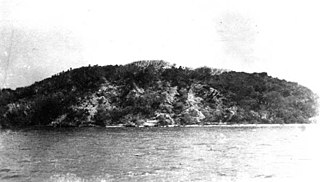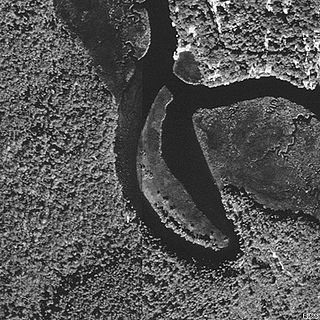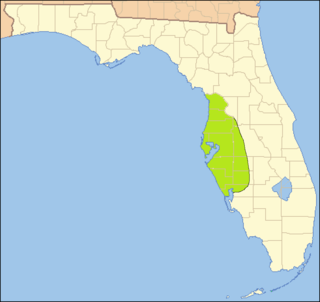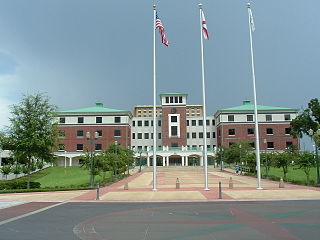
Ormond-by-the-Sea is a census-designated place and an unincorporated town in Volusia County, Florida, United States. The population was 8,430 as of the 2000 census.

The Adena culture was a Pre-Columbian Native American culture that existed from 1000 to 200 BC, in a time known as the Early Woodland period. The Adena culture refers to what were probably a number of related Native American societies sharing a burial complex and ceremonial system. The Adena lived in an area including parts of present-day Ohio, Indiana, Wisconsin, West Virginia, Kentucky, New York, Pennsylvania, and Maryland.

A charnel house is a vault or building where human skeletal remains are stored. They are often built near churches for depositing bones that are unearthed while digging graves. The term can also be used more generally as a description of a place filled with death and destruction.

Hopewell Culture National Historical Park is a United States national historical park with earthworks and burial mounds from the Hopewell culture, indigenous peoples who flourished from about 200 BC to AD 500. The park is composed of six separate sites in Ross County, Ohio, including the former Mound City Group National Monument. The park includes archaeological resources of the Hopewell culture. It is administered by the United States Department of the Interior's National Park Service.
The Weeden Island Cultures are a group of related archaeological cultures that existed during the Late Woodland period of the North American Southeast. The name for this group of cultures was derived from the Weedon Island site in Old Tampa Bay in Pinellas County.

The Halifax River is part of the Atlantic Intracoastal Waterway, located in northeast Volusia County, Florida. The waterway was originally known as the North Mosquito River, but was renamed after George Montagu-Dunk, 2nd Earl of Halifax, during the British occupation of Florida (1763–1784).

Turtle Mound is a prehistoric archaeological site located 9 miles (14 km) south of New Smyrna Beach, Florida, on State Road A1A. On September 29, 1970, it was added to the U.S. National Register of Historic Places. It is the largest shell midden on the mainland United States, with an approximate height of 50 feet (15 m). The mound extends for over 600 feet (180 m) along the Indian River shoreline and contains over 35,000 cubic yards (27,000 m3) of shells. Turtle Mound was estimated to be 75 feet (23 m) high before it was reduced by shellrock mining in the 19th and 20th centuries.

The Fort Walton Mound (8OK6) is an archaeological site located in present-day Fort Walton Beach, Florida, United States. The large platform mound was built about 850 CE by the Pensacola culture, a local form of the Mississippian culture. Because of its significance, the mound was designated a National Historic Landmark in 1964.

The Spruce Creek Mound Complex is a prehistoric and early historic archeological site in Port Orange, Florida. The mound complex, major earthworks built out of earth and shell middens, was constructed by ancient indigenous peoples. It is located near Port Orange, on the southwest bank of Spruce Creek. On December 3, 1990, it was added to the U.S. National Register of Historic Places.

Town Creek Indian Mound is a prehistoric Native American archaeological site located near present-day Mount Gilead, Montgomery County, North Carolina, in the United States. The site, whose main features are a platform mound with a surrounding village and wooden defensive palisade, was built by the Pee Dee, a South Appalachian Mississippian culture people that developed in the region as early as 980 CE. They thrived in the Pee Dee River region of North and South Carolina during the Pre-Columbian era. The Town Creek site was an important ceremonial site occupied from about 1150—1400 CE. It was abandoned for unknown reasons. It is the only ceremonial mound and village center of that culture located within North Carolina.

Nocoroco is the site of a Timucuan village located on the Tomoka River, in Tomoka State Park. The park is located two or three miles north of Ormond Beach, Florida on North Beach Street.

The Safety Harbor culture was an archaeological culture practiced by Native Americans living on the central Gulf coast of the Florida peninsula, from about 900 CE until after 1700. The Safety Harbor culture is defined by the presence of Safety Harbor ceramics in burial mounds. The culture is named after the Safety Harbor Site, which is close to the center of the culture area. The Safety Harbor Site is the probable location of the chief town of the Tocobaga, the best known of the groups practicing the Safety Harbor culture.

Fort Center is an archaeological site in Glades County, Florida, United States, a few miles northwest of Lake Okeechobee. It was occupied for more than 2,000 years, from 450 BCE until about 1700 CE. The inhabitants of Fort Center may have been cultivating maize centuries before it appeared anywhere else in Florida.

Fewkes Group Archaeological Site, also known as the Boiling Springs Site, is a pre American history Native American archaeological site located in the city of Brentwood, in Williamson County, Tennessee. It is in Primm Historic Park on the grounds of Boiling Spring Academy, a historic schoolhouse established in 1830. The 15-acre site consists of the remains of a late Mississippian culture mound complex and village roughly dating to 1050-1475 AD. The site, which sits on the western bank of the Little Harpeth River, has five mounds, some used for burial and others, including the largest, were ceremonial platform mounds. The village was abandoned for unknown reasons around 1450. The site is named in honor of Dr. J. Walter Fewkes, the Chief of the Bureau of American Ethnology in 1920, who had visited the site and recognized its potential. While it was partially excavated by the landowner in 1895, archaeologist William E. Myer directed a second, more thorough excavation in October 1920. The report of his findings was published in the Bureau of American Ethnology's Forty-First Annual Report. Many of the artifacts recovered from the site are now housed at the Smithsonian Institution. It was added to the National Register of Historic Places on April 21, 1980, as NRIS number 80003880.

Mound 72 is a small ridgetop mound located roughly 850 meters (2,790 ft) to the south of Monks Mound at Cahokia Mounds near Collinsville, Illinois. Early in the site's history, the location began as a circle of 48 large wooden posts known as a "woodhenge". The woodhenge was later dismantled and a series of mortuary houses, platform mounds, mass burials and eventually the ridgetop mound erected in its place. The mound was the location of the "beaded burial", an elaborate burial of an elite personage thought to have been one of the rulers of Cahokia, accompanied by the graves of several hundred retainers and sacrificial victims.

The Pompano Beach Mound, located at Indian Mound Park in Pompano Beach, Florida in Broward County, is a 100-foot (30 m) wide, 7-foot (2.1 m) tall oval Tequesta burial mound. It was listed on the National Register of Historic Places on April 17, 2014.
The Myakkahatchee Creek Archaeological Site (8SO397) is located in North Port in Sarasota County, Florida, United States. The site was discovered when the area was being prepared for housing in 1982. Crews building Cold Springs Lane and Reiterstown Road unearthed artifacts and human remains. Archaeologists discovered a rare inland multi-period Manasota Indian village near the Myakkahatchee Creek, a major transportation route from the Gulf of Mexico inland. What makes the site so rare is that evidence of 10,000 years of occupation was excavated and very little is known about inland villages. The Manasota people remained permanently settled as fishing–hunter–gatherers between Tampa Bay and Charlotte Harbor on the Gulf Coast of Florida. Culturally, they were the northernmost of the Glades south Florida culture region. Archaeologists found a large midden, as well as a large U-shaped ritual earthwork with a burial mound. The area has yet to be professionally excavated. The creek is now part of North Ports Myakkahatchee Creek Environmental Park.

The River Styx archaeological site is the site of a village and burial mound in North Central Florida that was occupied during the development of the Cades Pond culture out of the Deptford culture early in the Current Era (CE).

























